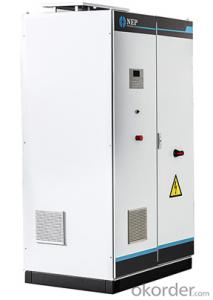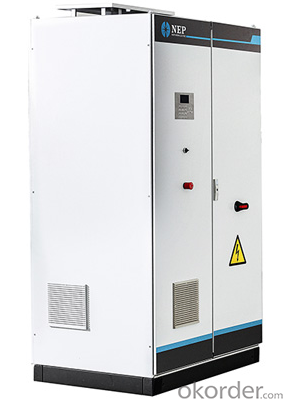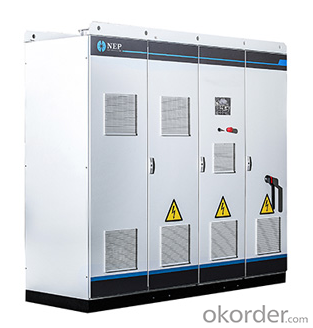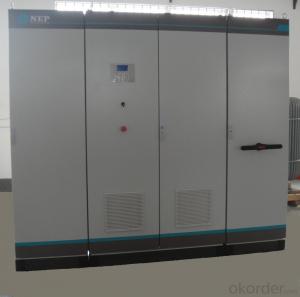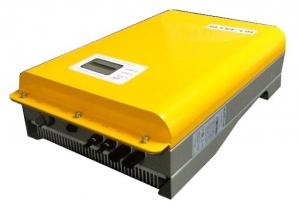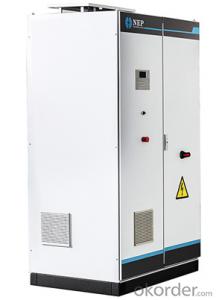Solar Inverter USA - Grid Tied Solar Inverter BDE-310K
- Loading Port:
- Qingdao
- Payment Terms:
- TT OR LC
- Min Order Qty:
- 10 unit
- Supply Capability:
- 1000 unit/month
OKorder Service Pledge
OKorder Financial Service
You Might Also Like
Description:
A solar micro-inverter, converts direct current (DC) electricity from a single solar panel to alternating current (AC). The electric power from several micro-inverters is combined and fed into an existing electrical grid. Micro-inverters contrast with conventional string or central inverter devices, which are connected to multiple solar panels.
Characteristic & Advantages:
More Energy Harvest: Distributed MPPT allows10~25% more energy harvest
Simple: Modularized,single ac cable to the house
Reliability: Longer life time and almost 100% operation hours
Security: No high Voltage, makes safter environments
Inteligent : Monitoring each module
Savings: No dc components and significantly save labor cost
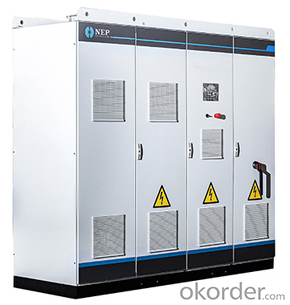
Datasheet:
| BDE-310K | |
(DC) | (kWp) | 340 |
(V) | 900 | |
(A) | 760 | |
MPPT | >99% | |
MPPT (V) | 450 - 820 | |
(AC) | (kW) | 310 |
(V) | 380/270 | |
(V) | 310-450/210-310 | |
(Hz) | 45.5—52.5 | |
THD | <3% ()< p=""> | |
| 0.92 () -- 0.92() | |
|
| 97.7% ()/ 98.6% () |
| 98.6%()/ 98.4% () | |
(W) | <10< p=""> | |
C (II) | ||
/ | ||
/ | ||
IP20 | ||
-35℃ -- +50℃ | ||
0-95% | ||
128*64 VFD | ||
RS485, RS232, , | ||
(-- mm) | 800*1800*2200 | |
(kg) | 1500/1060 | |
- Q: Are there any government regulations or certifications for solar inverters?
- Yes, there are government regulations and certifications for solar inverters. In many countries, solar inverters must comply with specific standards and regulations set by government bodies. Additionally, various certifications such as International Electrotechnical Commission (IEC) standards, UL listing, and CE marking are commonly required to ensure the safety, performance, and interoperability of solar inverters.
- Q: Can a solar inverter be used in systems with multiple solar arrays?
- Yes, a solar inverter can be used in systems with multiple solar arrays. In fact, it is common practice to connect multiple solar arrays to a single inverter, especially in larger solar installations. The inverter converts the DC power generated by the solar arrays into AC power that can be used by the electrical grid or consumed directly. By connecting multiple arrays to a single inverter, the overall system efficiency can be maximized, and it allows for easier monitoring and control of the entire solar power system.
- Q: How does a solar inverter handle power factor correction?
- A solar inverter handles power factor correction by converting the DC power generated by solar panels into AC power that is synchronized with the utility grid. It adjusts the phase and magnitude of the AC output to match the power factor requirements of the grid, ensuring efficient power transfer and reducing reactive power.
- Q: How does a solar inverter handle voltage drop in long cable runs?
- A solar inverter handles voltage drop in long cable runs by compensating for the drop in voltage through a process called voltage regulation. It adjusts the output voltage to ensure that the required voltage level is maintained at the point of connection to the solar panels. This allows for efficient power transmission and ensures that the system operates optimally despite the voltage drop caused by long cable runs.
- Q: How does a solar inverter handle power factor optimization?
- A solar inverter handles power factor optimization by ensuring that the power generated by the solar panels is synchronized with the grid's voltage and frequency. It adjusts the power factor by actively controlling the flow of current between the solar panels and the grid, allowing for efficient power transfer and minimizing reactive power consumption.
- Q: Can a solar inverter be used with both AC and DC power sources?
- No, a solar inverter is designed to convert DC power from solar panels into AC power for use in standard electrical systems. It cannot be used with both AC and DC power sources simultaneously.
- Q: What are the safety features in a solar inverter?
- Solar inverters, also known as photovoltaic (PV) inverters, play a crucial role in converting the direct current (DC) electricity generated by solar panels into alternating current (AC) electricity that can be used to power homes or businesses. In order to ensure the safe and efficient operation of solar inverters, they are equipped with various safety features. One of the primary safety features in a solar inverter is the ground fault protection. This feature is designed to detect any current leakage to the ground, which could indicate a fault in the system. If a ground fault is detected, the inverter will immediately shut down to prevent any potential electrocution hazards. To protect against overvoltage situations, solar inverters are equipped with surge protection devices (SPDs). These devices are responsible for diverting excessive voltage spikes or surges to the earth, thereby protecting the inverter and other connected electrical equipment from damage. In the event of a grid power outage or blackout, solar inverters are equipped with anti-islanding protection. This feature ensures that the inverter automatically disconnects from the grid, preventing any power backfeeding, which could pose a serious threat to utility workers trying to repair the grid. Temperature monitoring is another crucial safety feature in solar inverters. Since inverters can generate heat during operation, they are equipped with temperature sensors to monitor the internal temperature. If the temperature exceeds the safe limit, the inverter will automatically shut down to prevent any potential fire hazards. Furthermore, solar inverters are often equipped with built-in arc fault circuit interrupters (AFCIs). These devices are designed to detect and interrupt dangerous arc faults that can occur due to damaged or deteriorating wiring connections. By quickly stopping the flow of electricity, AFCIs help to prevent electrical fires. Lastly, many solar inverters have advanced monitoring and diagnostic systems. These systems provide real-time data and alerts, allowing users or installers to identify and address any potential safety issues promptly. Overall, the safety features in a solar inverter are crucial in ensuring the safe and reliable operation of the system. These features protect against electrical hazards, prevent damage to the inverter and connected equipment, and contribute to the overall safety of the solar power generation system.
- Q: What are the key features to consider when choosing a solar inverter?
- When choosing a solar inverter, there are several key features to consider. Firstly, the power rating or capacity of the inverter should match the size of your solar panel system to ensure efficient energy conversion. Additionally, the efficiency rating of the inverter is important as it determines how much energy is lost during the conversion process. It is also crucial to look for an inverter with reliable and durable components to ensure long-term performance and minimize maintenance costs. Other important features include the presence of monitoring capabilities, such as data logging and remote monitoring, which allow you to track the performance of your solar system. Finally, considering the warranty and customer support offered by the manufacturer is essential to ensure adequate support and protection for your investment.
- Q: Can a solar inverter be used with a solar-powered electric vehicle charging infrastructure?
- Yes, a solar inverter can be used with a solar-powered electric vehicle charging infrastructure. A solar inverter converts the direct current (DC) electricity generated by solar panels into alternating current (AC) electricity that can be used to charge electric vehicles. This allows for efficient and sustainable charging of electric vehicles using the power generated from solar energy.
- Q: How does a three-phase solar inverter differ from a single-phase inverter?
- A three-phase solar inverter differs from a single-phase inverter in terms of the number of phases they support. While a single-phase inverter is designed to work with a single-phase electrical system, a three-phase solar inverter is specifically designed to handle three-phase electrical systems. This means that a three-phase inverter can handle higher power loads and is more efficient in distributing power across the three phases, resulting in better overall performance and stability for three-phase electrical systems.
Send your message to us
Solar Inverter USA - Grid Tied Solar Inverter BDE-310K
- Loading Port:
- Qingdao
- Payment Terms:
- TT OR LC
- Min Order Qty:
- 10 unit
- Supply Capability:
- 1000 unit/month
OKorder Service Pledge
OKorder Financial Service
Similar products
Hot products
Hot Searches
Related keywords
